|

 Up
Up 
 The Flight
The Flight
of The Langley
Aerodrome

(You are here.)



  Need
to Need
to
find your
bearings?
Try
these
navigation aids:
If
this is your first
visit, please stop by:
Something
to share?
Please:



|
|
Available in Française, Español, Português, Deutsch, Россию,
中文, 日本, and others.
 s
morning dawned on 28 May 1914, the “Aerodrome A” perched like
a giant dragonfly on the edge of Lake Keuka, surrounded by
journalists, photographers, even a videographer. Members of the
scientific elite and Washington DC power structure were also there,
among them Charles Doolittle Walcott, the Secretary of the
Smithsonian Institution, and Albert Zahm, the director of the
recently reopened Langley Aerodynamical Laboratory. They carefully
spun the event for the media, explaining why they were attempting to
fly the infamous Langley Aerodrome eleven years after two
highly-publicized, unsuccessful, and nearly-catastrophic launch
attempts. s
morning dawned on 28 May 1914, the “Aerodrome A” perched like
a giant dragonfly on the edge of Lake Keuka, surrounded by
journalists, photographers, even a videographer. Members of the
scientific elite and Washington DC power structure were also there,
among them Charles Doolittle Walcott, the Secretary of the
Smithsonian Institution, and Albert Zahm, the director of the
recently reopened Langley Aerodynamical Laboratory. They carefully
spun the event for the media, explaining why they were attempting to
fly the infamous Langley Aerodrome eleven years after two
highly-publicized, unsuccessful, and nearly-catastrophic launch
attempts.
A cool breeze
blew down the lake, gently rocking the four tandem wings that
sprouted from the Aerodrome’s central framework. It was time to go.
As the sun crept higher in the sky the winds would kick up. With a
pronounced 12-degree dihedral between the pairs of 22-foot wings,
even a modest crosswind could flip the old aircraft if it got under
a wing. Workmen from the Curtiss Aeroplane and Motor Company of
Hammondsport, New York lined up along the pontoons and outriggers
recently added to the airframe. They lifted the half-ton aircraft a
foot or so above the ramp, duck-walked it into the water and turned
it into the wind.
Glenn Curtiss waded out, stepped onto the braces between the forward
pontoons and climbed into the nacelle that hung beneath the
framework. He settled into the cockpit and tested the familiar
Curtiss controls – wheel, post and shoulder yoke borrowed from one
of his early pushers. This system had replaced the dual
trim wheels that had steered the original Aerodrome. Workmen stood
in the shallow water behind the forward wings and swung the twin
propellers. The old Manly-Balzer engine sprang to life –
or as much life as it had left. It had been damaged by age or
carelessness and only produced two-thirds of the 52 brake horsepower
it had generated in 1903. To compensate, Curtiss had added a new
carburetor and high-tension magneto ignition. He also reshaped the
props, giving them a “bent-end” profile to increase the thrust. He
hoped it would be enough.
Curtiss
advanced the throttle and the Aerodrome moved forward. As it gained
speed, the wings fluttered a little but showed none of the
elasticity that had plagued Langley’s 1903 flight attempts.
Curtiss had replaced Langley’s flimsy, hollow-core ribs with pieces
of solid wood, laminated to hold the camber. He had also doubled-up
on the spars. In addition to the central spar atop each wing, there
was a second beneath it that stretched a third of the wing length.
He replaced the slender guy posts (to which the wing rigging was
attached) with sturdy A-frames and moved them backwards to better
coincide with the "center of pressure," the balancing point for the
forces that lifted the aircraft. All of this, when combined
with the brace work between the wings and the pontoons, greatly
strengthened the wings and made them less likely to deform or
collapse as they had eleven years before.
The Aerodrome
gained speed steadily, but painfully slowly. Curtiss was well out on
the lake and far from his audience when pontoons finally went up “on
the step” and the aircraft began to dance on the waves. He pulled
back on the wheel, praying there was enough lift. In rebuilding the
wings, he had altered the camber from a deep 1/16 to a much gentler
1/28. He did this by shortening the ribs, eliminating a section of
each wing forward of its leading spar. This also narrowed the chord
(wing width),
raised the aspect ratio (the chord compared to the wing span) and created a rounded leading edge
– all factors
known to boost the lift generated by a wing. Finally,
he had abandoned the semi-porous “percaline” used to cover the wings
in 1903 and substituted airtight doped cotton. The lift
was increased, if only just enough. The reconstructed Aerodrome left
the surface of Lake Keuka for a little over 3 seconds and traveled
150 feet through the air. It wasn’t much, but it was a flight. A
motorboat met Curtiss on the lake and towed the aircraft back to the
ramp.
Walcott and Zahm
were effusive. However short, they declared, this hop-flight
vindicated its inventor. If Langley’s Aerodrome was flyable now; it
could have flown in 1903. The media was less than impressed. The
flight had occurred far out on the lake, too remote for the
photographers or the filmmaker to capture it. Curtiss attempted a
second flight after breakfast, but it was aborted when the Aerodrome
threw a propeller.
Because it was
paramount that this event generate favorable press, Curtiss had the
media back five days later. This time he knew where to put them
along the lake shore so they could see the Aerodrome lift off. He
made several flights, none of them lasting more than a few seconds.
But the press got what they wanted, photos of Langley’s Aerodrome
with a little daylight showing between pontoons and water. They
dutifully printed the photos along with Walcott’s and Zahm’s
pronouncements. According to the June 6, 1914 edition of
Scientific American:
“The machine and its engine has been
shipped from the Smithsonian Institution to the Curtiss factory
in early April and was reclothed without change of size or
shape. The framing, the engine, propellers, wings, rudders, and
controls are, therefore, just as Langley left them… The brief
successful flight of May 28th proved that Langley’s invention had
been the first machine in history capable of prolonged free
flight with a passenger. A great scientist and inventor,
misunderstood and persecuted in his lifetime, is vindicated.”
|
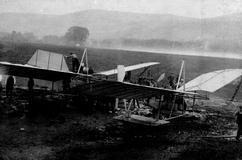
The 1903 Langley "Aerodrome A" being made ready for flight on the
shore of Lake Keuka 28 May 1914.
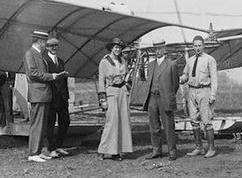
Standing in front of the Aerodrome, from left to right, Charles Walcott,
Glenn Curtiss, Walcott's daughter Helen, Albert Zahm and C.C.
Wittmer, a Curtiss pilot.
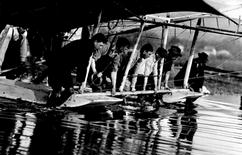
Curtiss workmen pick up the Aerodrome and walk it into the lake.
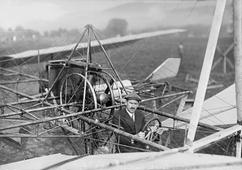
Glenn Curtiss in the cockpit of the Aerodrome on 28 May 1914. Note
the control wheel, post, and shoulder yoke are the same as were used
in the Model D, Triad, and other early Curtiss aircraft.
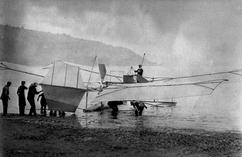
Workmen get ready to swing the props and start the engine. Curtiss
is standing up in the cockpit.
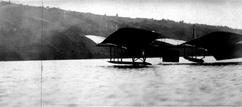
The Aerodrome lifts off from the surface of Lake Keuka.
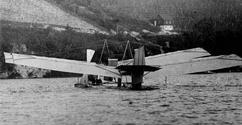
The Aerodrome is towed by motorboat back to to the shore.
|